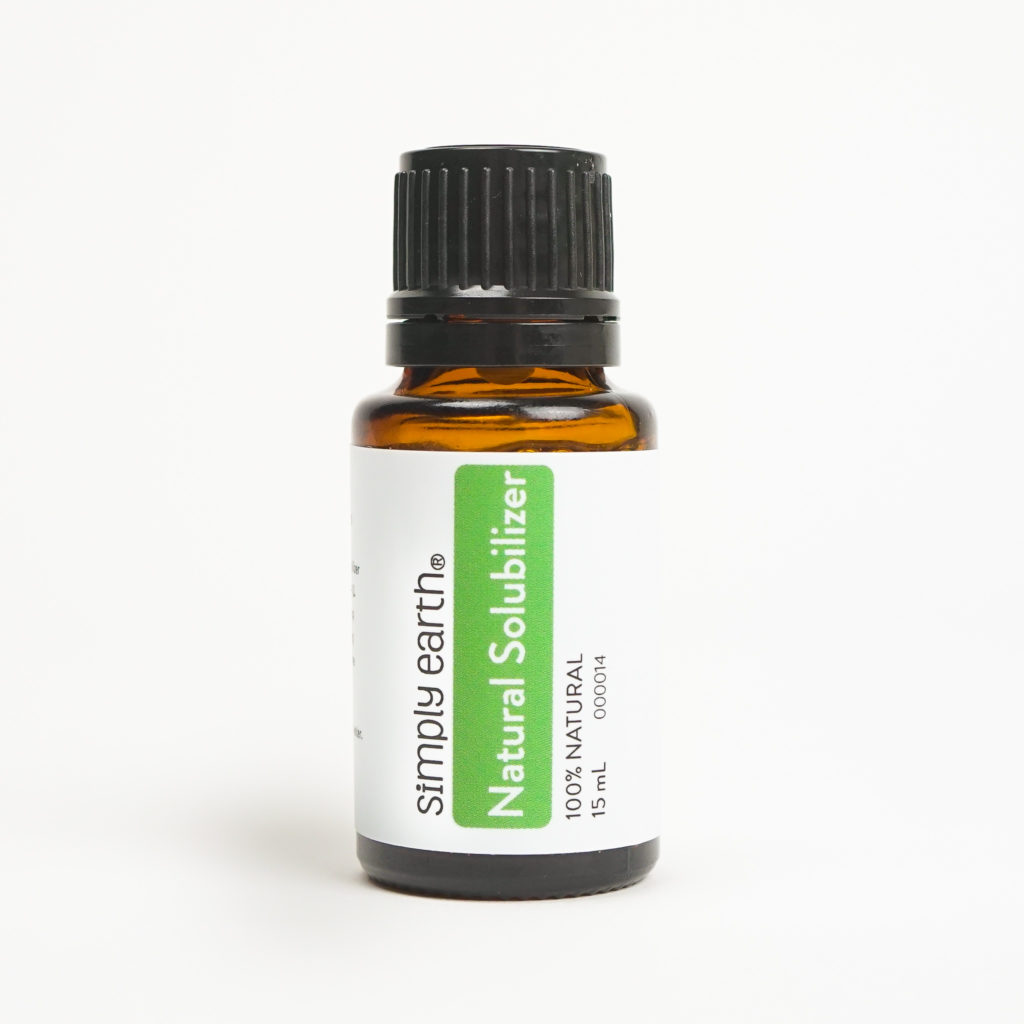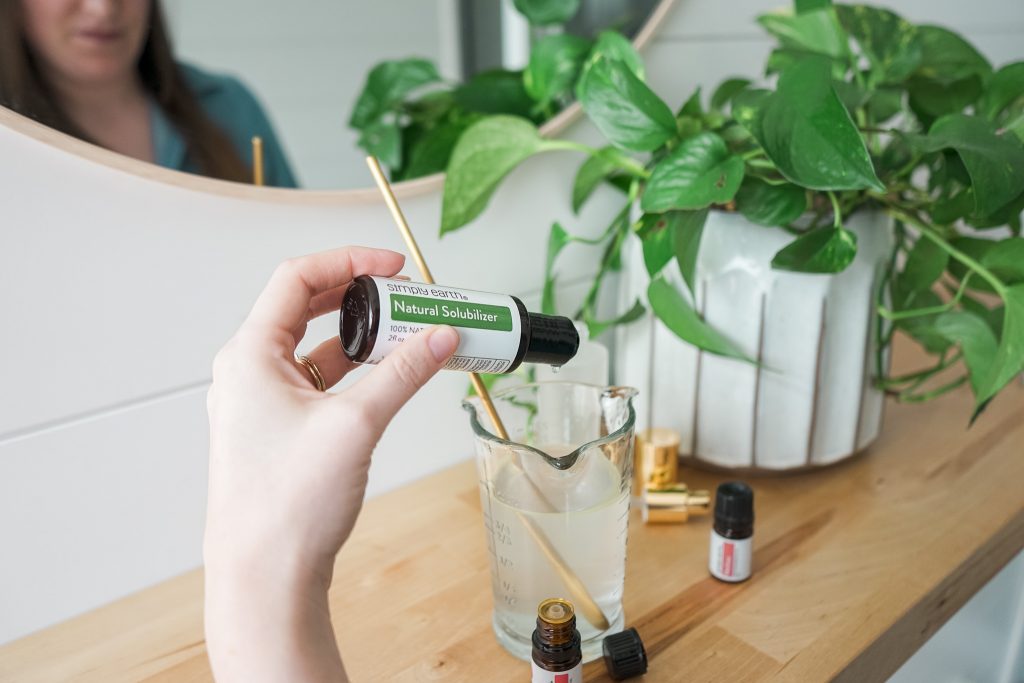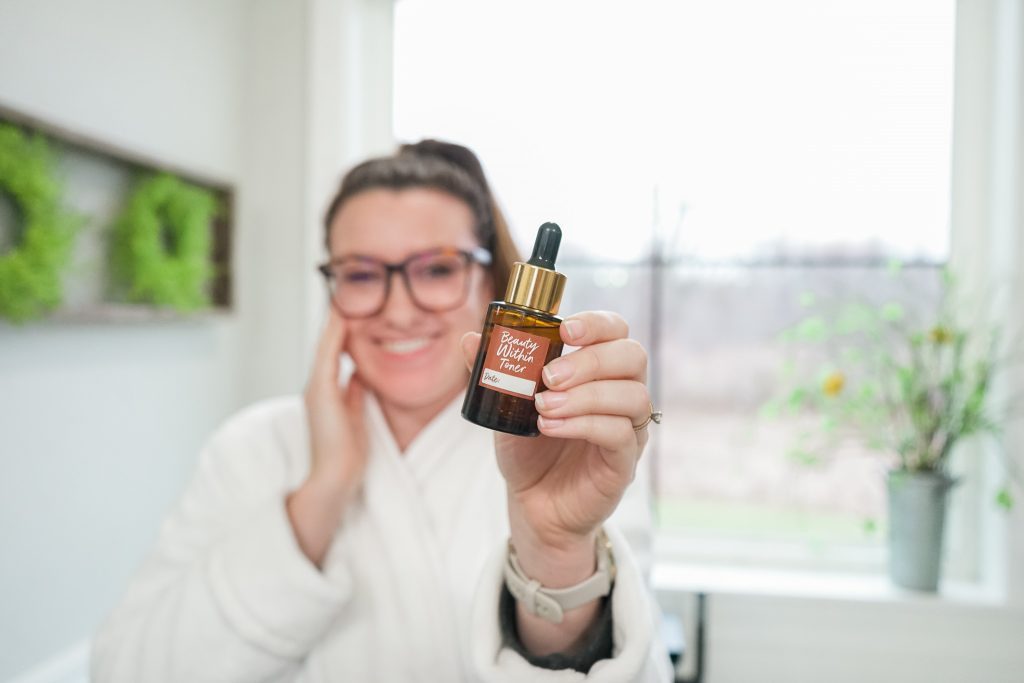Some things aren’t meant to go together–like oil and water.

However, as purveyors of essential oils, we need these two mixed. Water is an important ingredient in various recipes, and we can’t just do away with it. Here’s where science steps in. Men were sent to the moon; it would be a shame if we couldn’t mix oil and water.
Read on to learn everything you need to know about natural solubilizers to be able to make essential oil recipes like a pro.
What is a Natural Solubilizer?
As its name suggests, a solubilizer is an ingredient that helps make an insoluble ingredient soluble. When something is soluble, it means that it can be dissolved in water. Solubilizers are widely used in natural cosmetics as they help dissolve essential oils in mostly water formulations.
In some of our recipes where we did not use a solubilizer, like in this Happy Day Body Spray, we added a note to shake the recipe vigorously before each application. While this can work, the concentration of essential oils dispersed in each spray won’t be uniform.
How Solubilizers Work
A solubilizer, like an emulsifier, is a surface-active molecule or surfactant. Surfactants have both hydrophilic (water-loving) and lipophilic (fat or lipid-loving) traits, which means that they can connect the divide between oil and water.
It should be noted that solubilizers are completely water-soluble and only a little oil-soluble. This means they can combine only small amounts of oils into mostly water concoctions. Hence, solubilizers must only be used when adding a minute amount of essential oils to water in recipes like spray, hydrosol toners, etc. This is also why oil and water mixtures that use solubilizers can appear cloudy or hazy.
Why Use a Solubilizer
Even Dispersion of Essential Oils
As mentioned in the body spray example above, without a solubilizing ingredient, the dispersion of essential oils will vary from application to application.
With a solubilizer, however, the oils are uniformly mixed through the whole solution. So with every application, you can guarantee you’re getting the exact same concentration of oils in the mixture.
Improve Product Safety
When essential oils are not well-mixed in a product, there is a chance of under or overdosage. When it’s underdosed, you can’t fully reap the benefits of the essential oils in the recipe. And, when overdosed, undesired hazards, like sensitization or skin irritation, may happen since too much oil can be dispersed and touch your skin in a single application.
Improve Product Appearance
Without a solubilizer, a layer of oil may sit on top of the water or any hydrophilic ingredients in your recipe. That will make your product appear dysfunctional and unprofessional looking.
How to Use Simply Earth’s Natural Solubilizer

- To use Simply Earth’s Natural Solubilizer, start by placing your desired essential oils in a small bowl (I like to use a small beaker like you used in high school science class). Then, add a natural solubilizer in a 1:1 ratio with the essential oils you added. So, if you add 4 drops of essential oils, you’ll add 4 drops of a natural solubilizer.
- Stir this together. Look at your mixture. You’ll probably be able to see the essential oils floating around in the solubilizer. This means you need more solubilizer. Add more solubilizers in a 1:1 ratio to essential oils and stir until you have one even mixture of the solubilizer and essential oils. In our example, if we started with 4 drops of essential oils, we would keep adding 4 drops of the solubilizer and then stirring until we reach one even consistency.
- You’ll do this up to a 10:1 ratio (in our example, 40 drops of solubilizer to the 4 drops of essential oils). Typically, you’ll need less than the total 10:1 ratio. A good rule of thumb is to use as little as possible but as much as necessary.
- Once your mixture of the solubilizer and essential oil is one even mixture, you’ll slowly pour your desired amount of water into the mixture while stirring. The water will probably turn cloudy. This should clear up within 24 hours.
Tips for Using Simply Earth’s Solubilizer
Trial and Error
Unlike other ingredients, where there are clear instructions, using a natural solubilizer involves some trial and error.
Because essential oils are natural, each essential oil will combine with the solubilizer uniquely. Learning what you’re looking for requires a little practice, with the solubilizer and essential oils being one mixture. But, once you get the hang of it, this ingredient elevates your product and is fun to use.
Plus, recipes using natural solubilizers are typically fast to make and require only a few ingredients. If your recipe doesn’t turn out like you want, you can probably remake it with little time and ingredients lost.
Look for A Clear Mixture
As described in the ‘how to use’ section above, your end result should look like a clear mixture of essential oils.
The only exception is if the essential oil contains a natural pigment. In this case, the product will have an even tint to it. For example, German Chamomile is naturally a beautiful green color. With German Chamomile, your product should have a clear green tint with no cloudiness.
If your product remains cloudy for over 24 hours, this means you used too much solubilizer. This doesn’t harm the product you made; it’s just how it looks. You can adjust your recipe to use less solubilizer next time.
No Essential Oils Should Float
If you end up with essential oils floating on the top of your product, you should add more solubilizers next time.
If this happens in your recipe, you can remake it immediately, or you can keep the product as is and shake it before each use. If oils float on top, I will avoid using the product on the skin. Each time you spray the product, a different amount of essential oil will come out. This means you might get too much on your skin, and it could cause irritation.
Floating essential oils in a product are less of a concern in products not applied to the skin (like a room or linen spray).
Bubbles
Our natural solubilizer is also a surfactant. Because of this, you may notice some foam at the top of your DIY product. This will eventually settle out. Avoid shaking up your mixture, as it will cause your product to bubble up again. Surfactants are basically soap. You can use this property to make cleansing products like micellar water with a natural solubilizer.
Use A Preservative
You should add a preservative unless you use up your recipe very quickly. Because you’re working with water, your product will eventually go bad. Using clean bowls, tools, and distilled water can help your product last 2-6 weeks. If you want your product to last longer than that, I recommend adding Geogard ECT Preservative.
Simply Earth Recipes Using Our Natural Solubilizer

- Candied Clove Gel Air Freshener
- Blossom Reed Diffuser
- Beauty Within Toner
- Breath of Pine Shower Spray
- Clean Linen Spray
A FREE Cheat Sheet For You
If you’re looking for a more natural solution for solubilizing essential oils, we have the cheat sheet for you! Our free natural solubilizer cheat sheet covers everything you need to know about using our product. From tips and tricks to step-by-step instructions, we’ve got you covered. So what are you waiting for? Check out our free cheat sheet and get started today!

